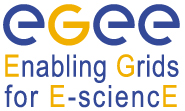Speaker
Describe the activity, tool or service using or enhancing the EGEE infrastructure or results. A high-level description is needed here (Neither a detailed specialist report nor a list of references is required).
The EPSRC pilot project "Meeting the Design Challenges of nanoCMOS Electronics" (nanoCMOS) has been funded to address the challenges facing the electronics industry caused by the decreasing "atomistic" dimensions of CMOS transisitors. This poster and demonstration will show how these challenges are being addressed through infrastructures supporting fine grained access control, large scale simulation and data management. This includes use of GANGA on resources such as ScotGrid and use of AFS.
Report on the impact of the activity, tool or service. This should include a description of how grid technology enabled or enhanced the result, or how you have enabled or enhanced the infrastructure for other users.
The poster and demonstration show the novel science that is now supported. We show how large scale simulations are supported through the use of GANGA and OMII-UK GridSAM software. This includes how we have supported simulations of hundreds of thousands of atomistically varying transistor devices. Based on these simulations, we have been able to examine the effect of device variability for simple circuits and have simulated over a million inverters using random configurations of such devices.
The major issue we have faced in delivering this infrastructure have included dealing with the copious amounts of data produced. The poster and demonstration will describe how the AFS have allowed to address many of these challenges, through coupling with meta-data management services exploiting web-based ideas.
Describe the added value of the grid for your activity, or the value your tool or service adds for other grid users. This should include the scale of the activity and of the potential user community, and the relevance for other scientific or business applications.
What is novel about this poster and demonstration is the strong industrial element to it. The electronics industry is a trillion dollar industry, hence fine grained and industrial strength security is not a mere requirement but a fundamental demand. Unless the infrastructure addresses all technical and non-technical requirements of the industrial collaborators they will simply not engage.
This poster and demonstration will show how large scale simulations combined with seamless security-oriented data management can support nanoCMOS electronics research. Key to this are the use of heterogeneous infrastructures including the UK e-Science National Grid Service and the ScotGrid infrastructure. We show in particular how we have exploited the Internet2 Shibboleth technology, VOMS, KereberosV, authorisation technology such as PERMIS and the Andrew File System based virtual file management in one seamless infrastructure.
Abstracts for online demonstrations must provide a summary of the demo content. Places for demos are limited and this summary will be used as part of the selection procedure. Please include the visual impact of the demo and highlight any specific requirements (e.g. network connection). In general, a successful demo is expected to have some supporting material (poster) and be capable of running on a single screen or projector.
The demonstration will introduce the nanoCMOS portal and the various services that it contains. We show how it is accessed through Shibboleth and configured based upon the roles and attributes pulled from the associated attribute authorities.
We show how large scale simulation is supported through Ganga and its use on ScotGrid, and how GridSAM can be used for submission to a variety of other resources.
We show how visualisation of results of simulations are supported through the OMII-Resource Aware Visualisation Environment (OMII-RAVE).
We show how data is managed and shared through AFS clients. We outline the benefits of this approach since it removes challenges with file staging. We show how group access and fine grained security over files is achieved through AFS and its use of KerbereosV tickets.




